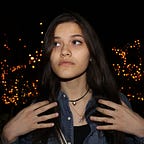New Hyde Park mural celebrates South L.A.
From the outside, Hyde Park’s AFIBA Cultural Center on Crenshaw Boulevard appears modest and small, surrounded by homes, dollar stores, and a bank. Inside, it is the site of local artists and kids coming together to bring a new mural to the South Los Angeles community.
The mural is called “The Heart of Hyde Park,” referring to the nearby neighborhood of Inglewood. Under the direction of lead artist Moses Ball and associate artist Dezmond Crockett, the mural is meant to celebrate the community of Inglewood as well as bring the visions of Hyde Park’s youth to life.
In an interview with both artists, Ball described the mural as a “commemoration of the people that are in the neighborhood.”
“This is the largest black neighborhood in California, but it’s also changing,” Ball said. “Gentrification is coming with the train, and there’s a lot of changes that are happening, so we wanted to have a mural that was like a love letter to the community and the people that are here.”
Crockett added, “I see all these other communities that have, like, these really awesome murals, and then I come back home, and it’s like we don’t have anything.”
Ball and Crockett are both Inglewood natives. Ball describes himself as a people painter, and has painted many murals around the South Los Angeles area. Crockett’s paintings also focus on people, having recently had his first solo exhibit which featured portraits of his muses and those who have inspired him.
The project was started by LA Commons, a nonprofit that aims to develop public art projects that tell the unique stories of LA’s neighborhoods. LA Commons also recruits local kids to help with the project.
“All of our work is focused on creating really locally-grounded initiatives,” said LA Commons’s founder and executive director, Karen Mack, in a phone interview. “We’re recruiting from local schools, neighborhood councils, and community groups.”
Ball enjoys having neighborhood kids involved in the project. He said they become “invested in it and feel a sense of pride in the community, and also whatever they create.” The artists outline the panels with tape to help kids paint inside the lines.
On some days, the artists will have up to 25 kids to work with. On others, they’ll have only two or three. “The students come on Saturdays and they’ve done pretty much the whole background, with all the blocks and symbols,” Ball said.
Though they just started painting last November, the two artists have been developing the project for over a year. They’ve held community events to come up with ideas for subjects to include on the mural, which Ball said helped them “get a sense of people in the community and what the neighborhood means to them.”
“We get ideas from the community, and then we have our students create visuals based on those ideas, and then we try to get a final image that encompasses all those things,” Ball said.
One pivotal event was held right outside the AFIBA building, the event in which Crockett felt the ideas for subjects to paint came together most. “We’d have kids hold these forms so that way they had questions they could ask people who attended about their thoughts on the neighborhood, and things that they would like to see on the wall that they felt best represented it,” Crockett said.
These events also helped promote the project. Crockett wanted to ensure that the community would know the project was underway, so that the mural wouldn’t just “pop up and then be some totally unrelated thing” that doesn’t mean anything to the community.
To keep the mural specific to the neighborhood, every person featured in the mural represents either a community hero or an everyday business owner or artist. “They’re all people that are respected and give back to the neighborhood for the most part,” Ball said.
One of these heroes is teacher and activist Ms. Asada. She is known throughout the community for telling kids the stories of the 1992 Los Angeles riots, in which 63 people were killed after thousands rioted to protest police brutality for six days.
The riots, called the Los Angeles uprising, are represented on the mural in a number of ways. The phoenix “represents how a lot of our buildings were burned down, and how we then kind of rose from the ashes and rebuilt the neighborhood through technology and art and community activism,” Ball said.
The artists hope the mural will be finished by the end of March, and anticipate its placement on the corner of Crenshaw and Slawson, right outside the AFIBA firehouse. There will be a community event to celebrate the project upon its completion.
“It’s pretty close to being done,” Crockett said. “We’ll just have the kids come in a few more Saturdays, and that should wrap up everything they need to do in order to help us out.”
At the same time, Ball and Crockett don’t want to rush the project, as they want to make sure the work they are putting out is the best it can be.
“It’s just kind of one of those things where we wanna make sure that we do it right,” Crockett said. “We want to set a precedent for what we can do and what we would like to see in the community, and what we think the community deserves.”
According to Ball, the mural will be installed the first week of May.
